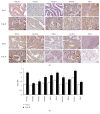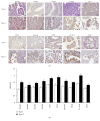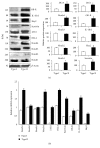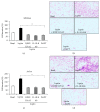Type II Endometrial Cancer Overexpresses NILCO: A Preliminary Evaluation
- PMID: 28659656
- PMCID: PMC5474242
- DOI: 10.1155/2017/8248175
Type II Endometrial Cancer Overexpresses NILCO: A Preliminary Evaluation
Abstract
Objective: The expression of NILCO molecules (Notch, IL-1, and leptin crosstalk outcome) and the association with obesity were investigated in types I and II endometrial cancer (EmCa). Additionally, the involvement of NILCO in leptin-induced invasiveness of EmCa cells was investigated.
Methods: The expression of NILCO mRNAs and proteins were analyzed in EmCa from African-American (n = 29) and Chinese patients (tissue array, n = 120 cases). The role of NILCO in leptin-induced invasion of Ishikawa and An3ca EmCa cells was investigated using Notch, IL-1, and leptin signaling inhibitors.
Results: NILCO molecules were expressed higher in type II EmCa, regardless of ethnic background or obesity status of patients. NILCO proteins were mainly localized in the cellular membrane and cytoplasm of type II EmCa. Additionally, EmCa from obese African-American patients showed higher levels of NILCO molecules than EmCa from lean patients. Notably, leptin-induced EmCa cell invasion was abrogated by NILCO inhibitors.
Conclusion: Type II EmCa expressed higher NILCO molecules, which may suggest it is involved in the progression of the more aggressive EmCa phenotype. Obesity was associated with higher expression of NILCO molecules in EmCa. Leptin-induced cell invasion was dependent on NILCO. Hence, NILCO might be involved in tumor progression and could represent a new target/biomarker for type II EmCa.
Figures






References
-
- Barakat R. R., Markman M., Randall M. Corpus: epithelial tumors. Principles and Practice of Gynecologic Oncology. 2009:683–686.
MeSH terms
Substances
LinkOut - more resources
Full Text Sources
Other Literature Sources
Medical

